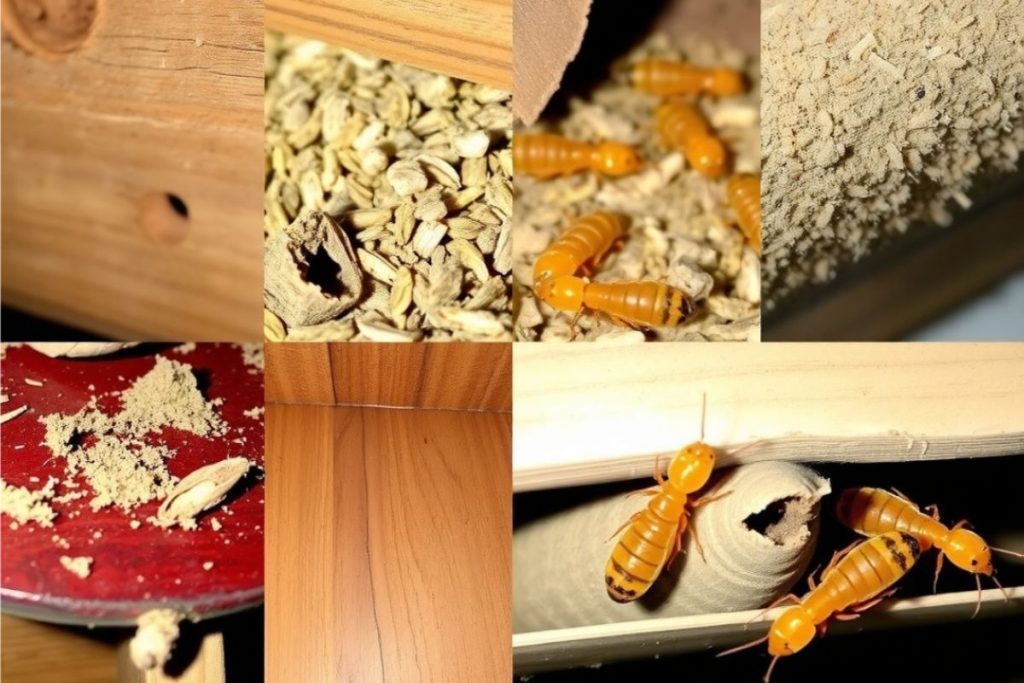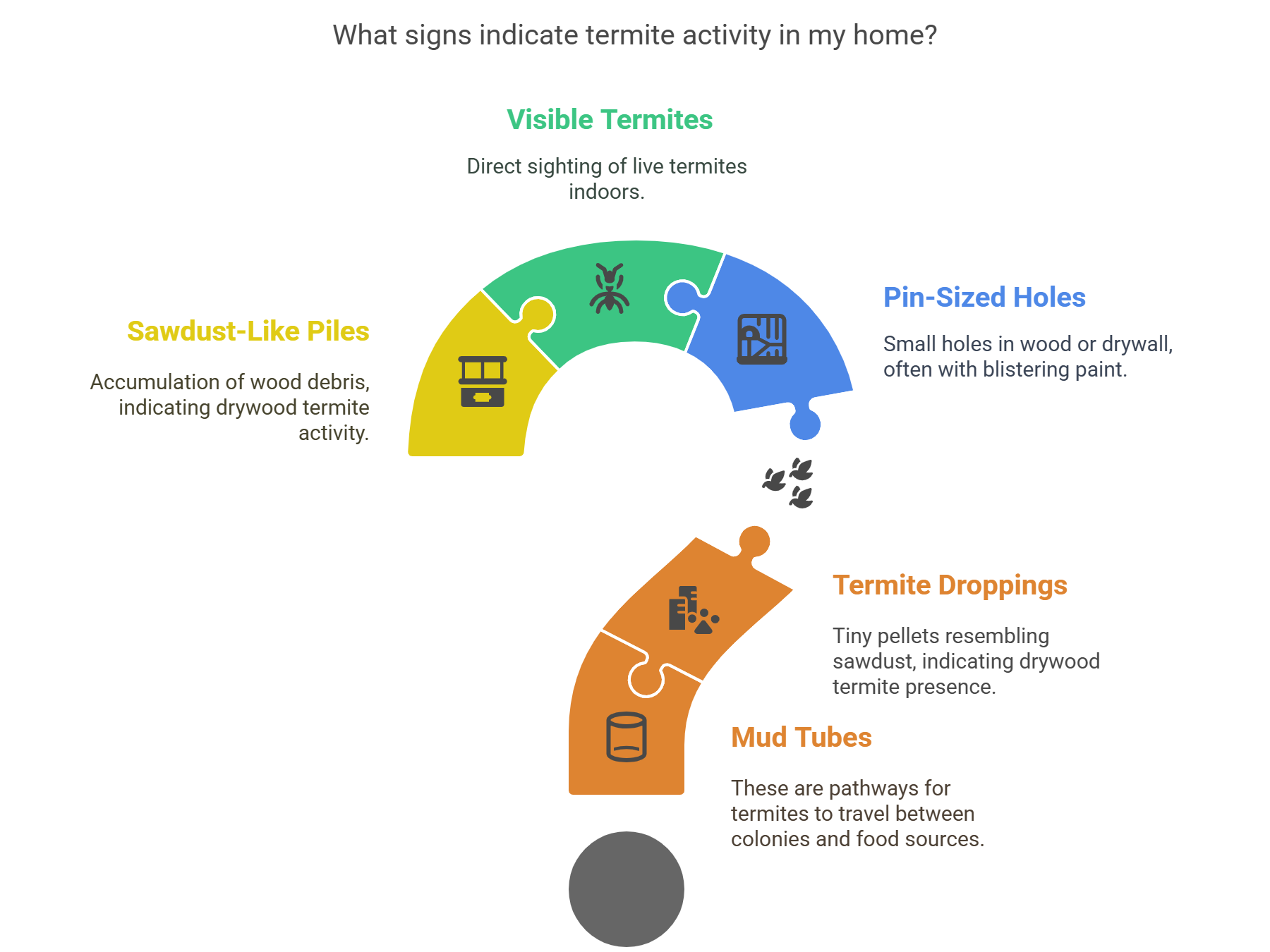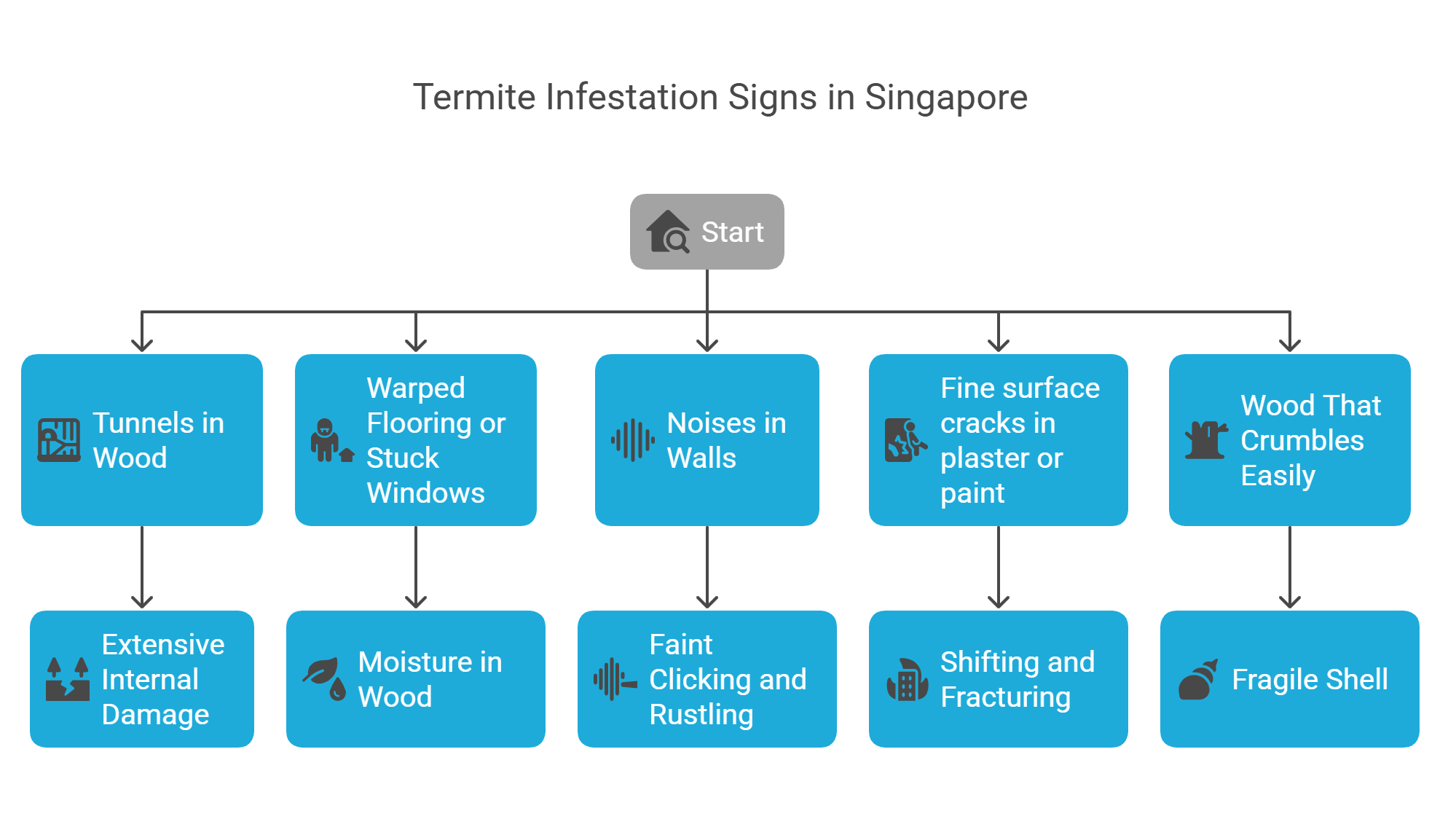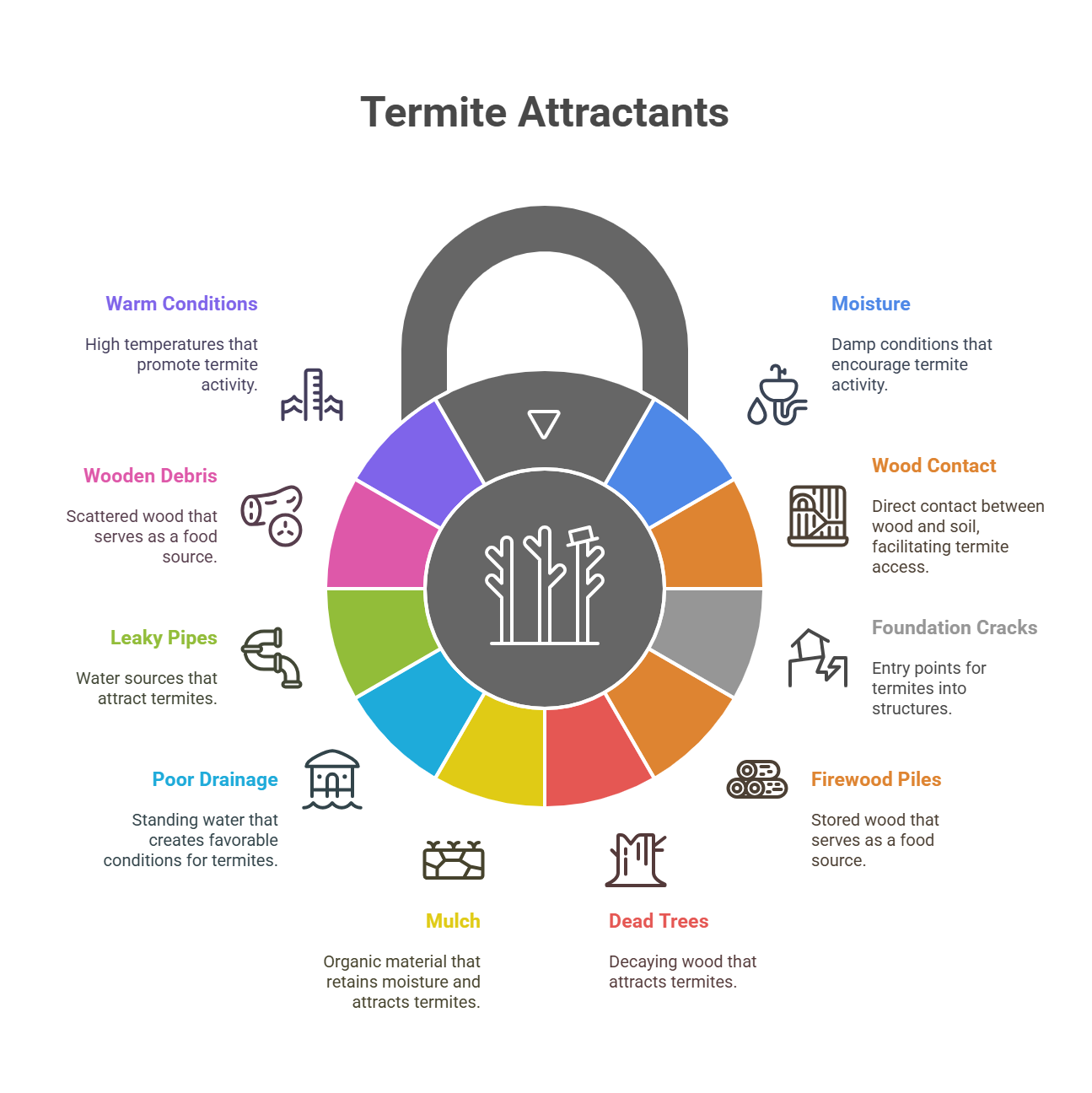Termites are destructive pests that annually cause billions of dollars in property damage in Singapore. You must identify the signs of infestation earlier to prevent damage to your business and residential properties, including furniture, walls, baseboards, and other items. Some common signs of these silent destroyers include mud tubes, droppings, discarded wings, visible termites, hollow-sounding wood, soft spots, and others. Keep your eyes open if you see any of these signs, to take the necessary steps and remove.

Visible Signs of Termite Activity in Singapore
Mud Tubes
Mud tubes are the obvious sign of termites, especially for subterranean termites. These shelter tubes are pencil-sized, cylindrical structures made of soil, termites’ saliva, and fecal matter, and create a pathway for termites to travel between their colonies and food sources. You will find these tubes along your foundation walls, crawl spaces, or beneath floorboards.
Termite Droppings
The tiny, oval-shaped pellets or frass are from drywood termites, resembling sawdust or coarse sand, and are colored tan or dark brown depending on the wood type. Termites kick out the frass through holes, and this accumulates behind. You will find the piles near furniture, baseboards, or attic beams, and this is a clear indication of termite infestation.
Discarded Wings from Swarmer Termites
Swarmer wings belong to reproductive termites, and these emerge during mating seasons near window sills, light sources, or entry points like doors. These swarmers shed their white wings after the nuptial fight and leave them scattered in small piles. You can assume that a nearby colony is preparing to expand soon.
Pin-Sized Holes, Kick-Out Holes, or Blistering Paint
Look for pin-sized small holes or kick-out holes in wood or drywall – typically 1-2 mm in diameter and accompanied by blistering or peeling paint. It happens when termites tunnel beneath the surface, which weakens the materials.
Visible Termites
There is nothing more obvious than finding live termites indoors- soft-bodied, white, pale or pale brown with straight antennae, a thick waist, and two equal-length wings. You will find them during spring or after rain. However, workers hide within soil and wood and are rarely seen.
Sawdust-Like Piles (Drywood Termite Activity)
Sawdust-like piles, also known as drywood termite frass, are different from carpenter ant debris that you will find beneath infested wood. It accumulates when termites push waste through kick-out holes. Regular discovery of such wood debris in your basements, attics, or near wooden furniture is a strong indicator of termite infestation.

Structural & Auditory Signs of the termites
You will find structural and auditory indicators for termite infestation.
Tunnels in Wood (Small, Carved-Out Channels)
Termites consume cellulose and create intricate carved-out channels, or termite tunnels, or galleries. These tunnels leave a honeycomb-like pattern in infested wood and cause extensive internal damage. You will find wood debris or frass when tunnels are made.
Warped Flooring or Stuck Windows
Termites add moisture when creating tunnels through wooden structures, causing the wood to warp and swell. It makes the floor uneven and the windows stick in the frames. If you notice warped flooring or tight-fitting windows, termites are likely present in your house.
Noises in Walls (Noisy Eaters)
Termites often make a faint clicking and rustling sound within walls when they chew through wood or tap their heads against walls to signal threats. You will notice the sound in a quiet environment or at night, and this is a clear indication of termite infestation.
Fine surface cracks in plaster or paint
The damaged wood walls caused by termite chewing can cause the wall to shift and fracture on the outer layer of the wall.
Wood That Crumbles Easily
Termites hollow out the wood’s internal part and create a fragile shell that can easily collapse under a small pressure. If the wood crumbles easily at touch points like door frames or baseboards, it is a late-stage indicator of termite damage.

Red Flags for Infestation Severity
Extensive Damage to Wooden Structures
Termites cause extensive damage to wooden structures such as timber, lumber, and sheetrock by consuming cellulose, weakening structural components. This level of destruction is a critical red flag for advanced termite activity within walls or other foundational elements.
Signs of a Mature Colony
A mature termite colony is a clear red flag where a large number of winged termites stay and breed. The number will grow soon, and the damage will increase.
Maze-Like Patterns Inside Wood
Termite galleries of maze-like patterns are a hallmark of termite infestation. These intricate, tunnel-like structures create a honeycomb appearance and weaken the wooden materials. However, it is hardly can since they often hide beneath intact surfaces. You will only see them when you cut or crumble the wood.
Buckling Floorboards
Another common severe indicator of termite-induced structural failure is buckling floorboards or sagging structures, leading to weak floor joists and support beams. It happens due to high moisture retention and extensive tunneling.
What are the Signs of Termites in Trees?
You will find mud tubes on tree trunks, hollowed bark, or frass piles, swarmers or discarded wings, tunnels within branches, and crumbling wood.
What are the Signs of Termites in the Yard?
Look for mud tubes along fences, stumps, or soil surfaces, swarmer wings scattered on the ground, small frass piles near wooden structures, maze-like tunnels in wood debris, and hollow-sounding yard timber.
What are the signs of Termites in the Wall?
You will hear clicking noises and find bubbling paint, small holes in drywall, hollow-sounding wood, frass piles, mud tubes along wall bases, swarmers, and discarded wings.
What are the Signs of Termites in Baseboards
You will see blistered or darkened baseboards, small holes, frass piles, hollow wood when tapped, crumbling surfaces under pressure, mud tubes, and swarmer wings nearby.
Signs of Termites in the Floor
Check for buckling or sagging floorboards, hollow-sounding wood, soft spots, mud tubes beneath flooring, frass near joints, warped surfaces, and small holes mimicking wood rot.
What are the Signs of Termites in the Ceiling
Finding sagging or buckling ceilings, blistered paint, small holes, hollow wood in beams, frass falling from above, clicking sounds, and swarmer wings are confirmed signs of termites in the ceiling.
What Are the First Signs of Termites
You will see mud tubes, discarded swarmer wings, frass piles, hollow-sounding wood, small holes, bubbling paint on walls or baseboards, clicking noises, and tight-fitting doors/windows in the first place as a sign of termite infestation.
What attracts termites to a house?
- Moisture
- Wood-to-soil contact
- Cracks in the foundation
- Firewood piles
- Dead trees or stumps
- Mulch near the foundation
- Poor drainage
- Leaky pipes
- Wooden debris
- Warm, humid conditions

How to inspect a termite infestation
Step 1: Understand the Need
Remember that termite infestation can cause property damage and disrupt regular lives. Performing the inspection early can prevent the damage from occurring.
Step 2: Check yourself
Before hiring a professional, conduct a DIY inspection yourself in highly infested areas like door and window frames, basements, and attics. Look for signs such as mud tubes, holes in wood, or wood-colored termite droppings. Probe wooden furniture, flooring, and walls with a screwdriver for hollowness.
Step 3: Look for Specific Signs
Look for termite nests, termite soldiers, worker termites, and soil for subterranean termite tunnels near foundations. Check for any maze-like patterns or wood debris for drywood, Formosan, or dampwood termites.
Step 4: Take Professional Help
Once you find termites or are still unsure about termite infestation, hire a professional termite inspector to use moisture meters and infrared scanners to find hidden damage and specific termite species.
Step 5: Take action
You can either use the DIY method or the professional method to eradicate termites and their colonies. However, a professional approach is better for heavy infestations since they will use targeted treatments with advanced technologies and eco-friendly solutions.
Termite Treatment Options
Termite Specialist PTE LTD suggests the following treatment from our core experience in this field.
- Bait Systems: Use different bait systems and bait stations to target subterranean termites. These systems lure termites, affect them, and destroy their colonies.
- Termiticides: Termiticides like sulfuryl fluoride are effective against drywood termite infestations.
- Spot Treatments: Try spot treatments for small and localized infestations.
- Non-Chemical Approaches: Explore non-chemical treatment plans such as treatments, orange oil, or electro-gun methods, for eco-friendly termite control.
Prevention: Proactive Measures to Protect Your Property
- Eliminate Moisture Sources by fixing leaky pipes and ensuring proper drainage to reduce termite-related moisture, since damp environments attract termites.
- Keep firewood away from your wood structures to limit access to a primary food source in humid environments.
- Ensure proper ventilation to reduce a damp environment.
- Install stainless steel mesh or sand barriers to prevent them from entering your house.
- Use treated wood in renovations and construction for continuous protection.
- Use borate solutions to treat the wood surface for a long-term solution.
- Perform regular inspections to identify early signs of infestations
Need Professional help?
Termite Specialist offer effective termite treatment, including Baiting Treatment. corrective and soil treatment. Contact us today or visit our office. Get directions.
